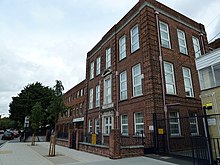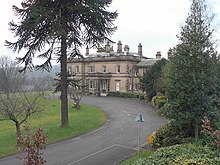Direct grant grammar school
One quarter of the places in these schools were directly funded by central government, while the remainder attracted fees, some paid by a Local Education Authority and some by the pupils' parents or guardians.The status was introduced in England and Wales by the Education Act 1944 as a modification of an existing direct grant scheme to some long standing endowed grammar schools.In the 19th century, few boys and very few girls in England and Wales received secondary education, which was typically available only from charity, endowed or private schools.[5] In the latter part of the century, many of the less wealthy schools received annual grants from the Department of Science and Art and from their county councils.[7] Secondary schools controlled by voluntary bodies could receive a grant from either the Board of Education or their local authority, or both.At the same time, the state-funded sector had grown to the point where universal secondary education seemed achievable, and changes in society had made the idea more popular.[16] The remaining ("residuary") places would attract fees, but no child would be admitted unless they had achieved the required standard in the eleven plus.[a] Many of the schools were in the north of England, with 46 in the historic county of Lancashire (including Manchester) and 18 in the West Riding of Yorkshire, while there were only 7 in inner London and 4 in Wales.[34] On average, three-quarters of pupils came from white-collar homes, including 60% with fathers in management or the professions, while only 7% were children of semi-skilled or unskilled workers.[36] Their results were correspondingly high, with 60% of their pupils staying on to age 18 and 38% going on to university, significantly greater proportions than either of the other groups of schools.[51] During the post-War period, many parts of the world moved from selective education to comprehensive schools catering for children of all abilities.[56] The commission, now chaired by David Donnison, issued its second report in 1970, concluding that "Grammar schools of the traditional kind cannot be combined with a comprehensive system of education: we must choose what we want."[57] They recommended that the schools choose between becoming voluntary aided comprehensives and full independence, but the Conservatives came to power before any action had been taken.[61] A respite was provided in the early 1970s, when Margaret Thatcher, the Conservative Education Secretary, raised the level of grant, which had been lowered by the Labour government.[27] Of the 174 remaining direct grant grammar schools,[63] 51 (two Church of England and the rest Catholic) applied to join the state sector, of which 46 were accepted.[65] One school, St. Joseph's College, Stoke-on-Trent, was approved to join the state system, but became independent instead following a campaign by parents.[69] An echo of the direct grant, the Assisted Places scheme, was introduced by the Conservative government of Margaret Thatcher in 1981, lasting until 1997.








The Manchester Grammar Schoolselectivesecondary schoolLocal Education AuthorityEngland and WalesEducation Act 1944endowedgrammar schoolslocal authoritiesTripartite Systemmaintainedprivate schoolscomprehensivecomprehensive schoolsRoman CatholicFrances BussNorth London Collegiate SchoolEton CollegeWinchester CollegeEndowed Schools Act 1869Roman Catholic Relief Act 1829joint-stock companiesGirls' Public Day School CompanyDepartment of Science and ArtBoard of EducationEducation Act 1902countiescounty boroughslocal education authoritiesEducation (Administrative Provisions) Act 1907Great DepressionHeadmasters' ConferenceR.A. ButlerLord FlemingBradford Grammar Schooleleven plus examgrammar schoolvoluntary controlledvoluntary aided schoolsHer Majesty's Inspectors of Schoolsgoverning bodiesindependent schoolsCulford SchoolList of direct grant grammar schoolsA-levelChurch of EnglandMethodistWest Riding of YorkshireLeeds Grammar SchoolHeadmaster's ConferenceEric JamesHaberdashers' Aske's SchoolLatymer Upper Schoolpublic schoolsFramlingham CollegeDr Williams' SchoolDolgellauGirls' Day School Trustsecondary modern schoolsAngleseyMidlandsYorkshireLabourDepartment of Education and ScienceCircular 10/65St Anne's Convent SchoolSt Anthony's Schoolvoluntary aidedConservativesTrinity School of John WhitgiftOakham SchoolTeesside High SchoolMargaret ThatcherNotre Dame High SchoolSt. Joseph's College, Stoke-on-Trentsixth form collegesDr Williams Schoolmid-1970s recessionAssisted Placesgrant-maintained schoolsacademiesSutton TrustArmorial of schools in the United KingdomList of English and Welsh endowed schools (19th century)Queen Victoria High SchoolAnthony SampsonBaroness BaconParliamentary Debates (Hansard)House of Commons LibraryHer Majesty's Stationery OfficeFleming, DavidRoutledgeMethuenManchester University PressSampson, AnthonyThe New Anatomy of BritainHodder & StoughtonSpens, WillTawney, Richard H.George Allen & UnwinColumbia University